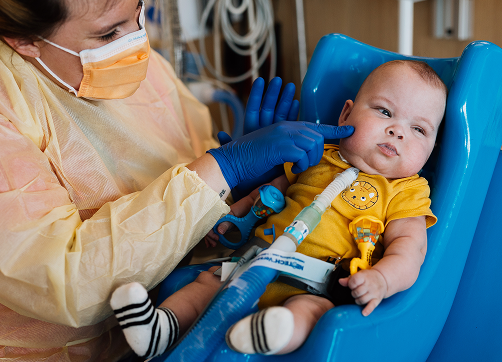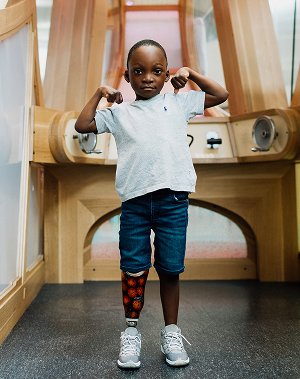carpenter syndrome


about condition
Carpenter syndrome is a rare craniofacial genetic condition apparent at birth or shortly thereafter. Symptoms will vary widely among individuals from mild to severe, even among affected members of the same family. A key feature of this condition is the premature fusion of cranial sutures between certain skull bones, thereby affecting the shape of the head (craniosynostosis). This premature fusion prevents the head from growing as it should, which often leads to a cone-shaped head. In addition, fingers and toes may be affected (fused/webbed, shortened or extra digits). Additional craniofacial malformations may include down-slanting eyelids, a flat nasal bridge, malformed or low-set ears, as well as underdeveloped upper and/or lower jaws. Carpenter syndrome can often present with asymmetry where one side of the head/face differs from the other. Other characteristics may include heart defects, vision and dental issues. Intellectual challenges are often present. This syndrome was first noticed by George A. Carpenter, a pediatrician, in 1901 with two sisters; however, the syndrome was officially named after Dr. Carpenter in 1909 after the sisters’ brother was born with a more severe expression of the syndrome.
Carpenter syndrome belongs to a group of rare genetic conditions known as “acrocephalopolysyndactyly” (ACPS) conditions. All forms of ACPS are characterized by the premature fusion of the cranial sutures – craniosynostosis. Carpenter syndrome is also known as ACPS type II. It is interesting to note that long ago, it was thought that there were many different types of this syndrome in the ACPS group, but over time, researchers recognized that some of the conditions were actually other syndromes that just had overlapping characteristics, like what became known as Pfeiffer syndrome.
symptoms
Since this condition has such a broad array of characteristics, this is an overview of some of the characteristics and symptoms:
- Mild to severe skull malformation (craniosynostosis)
- Head shape can be short from front to back; cone shape from top to bottom
- Head/face shape may be asymmetrical
- Down-slanting eyelid folds (palpebral fissures)
- Vision issues
- Misshapen or low-set ears
- Hearing loss
- Undeveloped upper and/or lower jaws
- Dental malformations
- Intellectual challenges
- Organ issues (heart, lungs, kidneys)
- Heart may be on the right side instead of the left side
- Possible short stature/obesity
- Unusually short fingers/toes (brachydactyly)
- Partial webbing between fingers and toes (syndactyly)
- Extra toes/less common are extra fingers (polydactyly)
- Failure in males for the testes to descend into the scrotum

how do you treat Carpenter syndrome?
The treatment of Carpenter syndrome is focused on the specific symptoms apparent in each individual since the symptoms can vary so widely. Several specialties and physicians may be involved throughout the child’s life. Craniofacial and reconstructive surgeries may be necessary to correct skull and head malformations, and possible airway issues. Additional surgeries to correct other skeletal malformations may be required, along with surgical correction of fingers and toes. Patients may see some or all of the following physicians and specialties: otolaryngologist (ENT), audiologist, cardiologist, neurologist/neurosurgeon, ophthalmologist, dentist, orthodontist, oral surgeon, orthopedic surgeon and more. Early intervention may be important to ensure that children with this syndrome reach their full potential. Several services like physical, occupational and speech therapies, along with special education may be very beneficial.
faqs
Extremely rare; this condition is estimated to only occur in 1 out of every 1,000,000 births. To date, medical literature states only 70 cases.
Yes, this syndrome is congenital and usually apparent at birth. It is an autosomal recessive condition, which means both parents of an affected individual each have one copy of this mutated gene; both parents must each pass their copy on for the child to inherit the syndrome. The parents typically do not show any characteristics or symptoms of the condition even though they both carry the mutated gene, which is why it is called a recessive condition. If both parents carry the mutated gene copy, then there is always a 25% chance of passing the syndrome to their children.
Individuals with Carpenter syndrome can have a typical life span. However, those affected more severely can have more complications which could lead to a shortened life span. Much depends on the timing of corrective surgeries. With individuals having intellectual challenges, independent living is not assured.
Sometimes when an ultrasound is performed during pregnancy, a doctor may notice non-typical signs which require additional testing. More in-depth testing with 3D or 4D ultrasounds, or a fetal MRI can reveal much more detail. After birth, clinical examinations, CT scans, MRI, genetic and other testing can help to diagnose the syndrome.
If both parents are known to each carry a copy of the mutated gene, genetic testing can be done early in the pregnancy to test for that mutation in the fetus. As previously noted, ultrasound scans can be done to look for craniofacial malformations. Genetic counseling is highly recommended for having or considering a future family. If your mutation is found, always retain a copy of the genetics report from the genetics department for safekeeping.
There are presently two genes responsible for this condition:
- RAB23; Chromosome 6
- MEGF8; Chromosome 19
The genes that cause this condition to occur play important and critical roles in skeletal and organ development. Genes give instructions for creating the proteins that play vital roles in our body. When a mutation change in a gene occurs. the protein that is important for building structures is disrupted. When a mutation change happens in a gene for this syndrome, it results in the loss of communication of instructions to the cells. This means the sutures in the brain do not form as they should, so consequently, this can disrupt the development of other craniofacial structures in the head and also the body. Researchers understand what happens once the mutation occurs, but they don’t know what causes it to mutate. More research needs to be done on this very rare syndrome.
- ACPS II
- Acrocephalopolysyndactyly 2
- Acrocephalopolysyndactyly type II
- Acrocephalosyndactyly, type II
- Type II acrocephalosyndactyly
here when you need us
Whether you’re looking for the right provider, ready to make an appointment, or need care right now—we’re here to help you take the next step with confidence.
